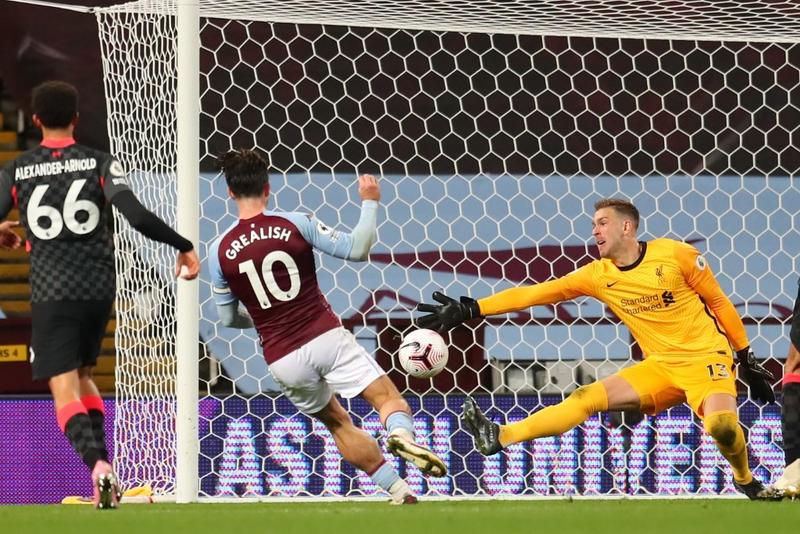 Tottenham Hotspur's South Korean striker Son Heung-min (left) shoots to score his team's fourth goal past Manchester United's Spanish goalkeeper David de Gea (right) during the English Premier League football match between Manchester United and Tottenham Hotspur at Old Trafford in Manchester, north west England, on Oct 4, 2020. (OLI SCARFF / AFP)
Tottenham Hotspur's South Korean striker Son Heung-min (left) shoots to score his team's fourth goal past Manchester United's Spanish goalkeeper David de Gea (right) during the English Premier League football match between Manchester United and Tottenham Hotspur at Old Trafford in Manchester, north west England, on Oct 4, 2020. (OLI SCARFF / AFP)
LONDON - When Liverpool began the defence of their Premier League crown with a 4-3 win over promoted Leeds United last month it opened the floodgates for an unprecedented deluge of goals in the opening weeks of the season.
Liverpool conceded seven for the first time since 1973 in a freakish 7-2 drubbing at Aston Villa, hours after Tottenham thrashed Man United 6-1 at Old Trafford
In 38 fixtures the net has bulged 144 times at an average of 3.79 per game, the most prolific opening four weeks of a top-flight season for 60 years.
In the round of matches before the international break, Liverpool conceded seven for the first time since 1973 in a freakish 7-2 drubbing at Aston Villa, hours after Tottenham Hotspur thrashed Manchester United 6-1 at Old Trafford.
Data company Gracenote Sports has been crunching the numbers behind the glut of goals and surprisingly found that less, not more, chances are being created.
ALSO READ: Premier League clubs reject 'Project Big Picture'
Gracenote said there have been 22.6 shots per match, 1.5 fewer than the first four rounds last season and the lowest figure for 10 years.
Crucially, however, a goal is being scored every six attempts compared to the usual nine or 10.
Logic suggests that either the quality of attacking players has improved or goalkeepers and defences are inferior, the latter scenario supported by the fact that keepers are saving 59 percent of on-target attempts compared to the 70 percent they usually keep out and that there is less tackling.
While 23 goals have come from penalties in the first four weeks, a record, Simon Gleave, head of sports analysis at Nielsen’s Gracenote, said that does not explain the rise.
“The current goal rush is built on a stunning increase in the conversion of opportunities,” he said.
 Aston Villa's English midfielder Jack Grealish (center) scores their seventh goal past Liverpool's Spanish goalkeeper Adrian during the English Premier League football match between Aston Villa and Liverpool at Villa Park in Birmingham, central England on Oct 4, 2020. (CATHERINE IVILL / POOL / AFP)
Aston Villa's English midfielder Jack Grealish (center) scores their seventh goal past Liverpool's Spanish goalkeeper Adrian during the English Premier League football match between Aston Villa and Liverpool at Villa Park in Birmingham, central England on Oct 4, 2020. (CATHERINE IVILL / POOL / AFP)
“Shots from all over the pitch are being scored more often than expected. Defenders and goalkeepers are conceding more frequently than the data suggests they ought to.”
So is the fact that matches are taking place in empty stadiums because of the COVID-19 pandemic triggering the goal spree?
Matthew Shaw, a performance psychologist for London-based InnerDrive, says the odd match-day atmosphere could certainly be a factor in helping strikers be more clinical, allowing them to score with the freedom they show on the training ground.
“One reason things normally go better on the training ground than on the pitch is that there are less consequences on the practise pitch,” Shaw told Reuters.
“Fear of failure, missing a chance for example when one-on-one with the keeper, can make responses less automatic. With a crowd in the stadium a player will be more aware of the repercussions of missing that chance.
More clinical
“When people are under pressure they tend to go back to older worse habits rather then be on auto-pilot, so that’s maybe an explanation as to why players are being more clinical.”
Shaw says the finger should not necessarily be pointed at inferior goalkeeping.
“One of the weapons a keeper usually has is the pressure a striker might feel,” he said.
“If I’m a keeper with a striker coming towards me I want the striker focusing on as many things as possible, whereas a striker wants to focus on as few things as possible.
“In the current environment, it’s maybe easier for the striker to focus on fewer things, focus on the relevant cues like the keeper, the goal, the back of the ball.”
Gracenote figures reveal that tackles per game have dropped from 34 last season in front of crowds to 29.
READ MORE: Everton's renaissance set for ultimate derby test
“Maybe without the extra motivating factor of the crowd effect players are less likely to jump into tackles they are never going to win,” Andy Hill, a performance psychologist with the English Institute of Sport who works with Blackburn Rovers, told Reuters.
“Crowds can cause stress, anxiety and fear in players but they can also energise, especially defenders who don’t want the verbal abuse from the crowd for not closing down or allowing a goal to be scored,” he added.
“Take that away and it could mean they take their foot off the throttle a fraction and that can make the difference between reading a pass and missing it or failing to make a tackle.”



